I'm attempting to create a Rubik's Cube in Python, i have gotten as far as visually representing the cube. Struggling a bit with how to implement rotation.
I guess i'm asking for feedback as to how to go about doing this. I thought at first of, rotating each cubes set of vertices's, without much luck.
I basically want to select a slice from an array of cube objects (of varying size), perform a rotation and a translation on each object.
import pygame
import random
from pygame.locals import *
from OpenGL.GL import *
from OpenGL.GLU import *
vertices = (
(1, -1, -1),
(1, 1, -1),
(-1, 1, -1),
(-1, -1, -1),
(1, -1, 1),
(1, 1, 1),
(-1, -1, 1),
(-1, 1, 1)
)
edges = (
(0,1),
(0,3),
(0,4),
(2,1),
(2,3),
(2,7),
(6,3),
(6,4),
(6,7),
(5,1),
(5,4),
(5,7)
)
surfaces = (
(0,1,2,3),
(3,2,7,6),
(6,7,5,4),
(4,5,1,0),
(1,5,7,2),
(4,0,3,6)
)
colors = (
(1,0,0), #Red
(0,1,0), #Green
(1,0.5,0), #Orange
(1,1,0), #Yellow
(1,1,1), #White
(0,0,1), #Blue
)
class Cube():
'''set the vertices edges and surfaces(colored) for a Cube'''
def __init__(self):
'''initiate the display to show the cube'''
pygame.init()
display = (800,600)
pygame.display.set_mode(display, DOUBLEBUF|OPENGL)
glEnable(GL_DEPTH_TEST)
gluPerspective(45, (display[0]/display[1]), 0.1, 50.0)
glTranslatef(1,1, -40)
def setVertices(self, xmove, ymove, zmove):
'''set predefined vertices'''
xValueChange = xmove
yValueChange = ymove
zValueChange = zmove
newVertices = []
for vert in vertices:
newVert = []
newX = vert[0] + xValueChange
newY = vert[1] + yValueChange
newZ = vert[2] + zValueChange
newVert.append(newX)
newVert.append(newY)
newVert.append(newZ)
newVertices.append(newVert)
return newVertices
def CreateCube(self, vertices):
'''create with OpenGL'''
glBegin(GL_QUADS)
x = 0
for surface in surfaces:
glColor3fv(colors[x])
x+=1
for vertex in surface:
glVertex3fv(vertices[vertex])
glEnd()
class EntireCube():
def __init__(self,typeOfCube):
self.typeOfCube = typeOfCube
self.NewCube = Cube()
def createEntireCube(self):
'''for each dimension x,y,z make a dictionary containing the vertices to be displayed'''
self.cubeDict = {}
count = 0
for x in range(self.typeOfCube):
for y in range(self.typeOfCube):
for z in range(self.typeOfCube):
self.cubeDict[count] = self.NewCube.setVertices(x*2.1,y*2.1,z*2.1)
count += 1
def mainloop(self):
'''key events, creates the matrix of cubes'''
rotateUpKey, rotateDownKey, rotateLeftKey, rotateRightKey = False, False, False, False
rotationalSensitivity = 2
while True:
for event in pygame.event.get():
if event.type == pygame.QUIT:
pygame.quit()
quit()
if event.type == KEYDOWN:
if event.key == K_UP:
rotateUpKey = True
if event.key == K_DOWN:
rotateDownKey = True
if event.key == K_LEFT:
rotateLeftKey = True
if event.key == K_RIGHT:
rotateRightKey = True
if event.type == KEYUP:
if event.key == K_UP:
rotateUpKey = False
if event.key == K_DOWN:
rotateDownKey = False
if event.key == K_LEFT:
rotateLeftKey = False
if event.key == K_RIGHT:
rotateRightKey = False
if rotateUpKey:
glRotatef(rotationalSensitivity,-rotationalSensitivity,0,0)
if rotateDownKey:
glRotatef(rotationalSensitivity,rotationalSensitivity,0,0)
if rotateLeftKey:
glRotatef(rotationalSensitivity,0,-rotationalSensitivity,0)
if rotateRightKey:
glRotatef(rotationalSensitivity,0,rotationalSensitivity,0)
#eventually implement keysbindings to call function to rotate a slice of the matrix created
# x = glGetDoublev(GL_MODELVIEW_MATRIX)
glClear(GL_COLOR_BUFFER_BIT|GL_DEPTH_BUFFER_BIT)
for eachCube in self.cubeDict:
self.NewCube.CreateCube(self.cubeDict[eachCube])
# glPushMatrix()
# glRotatef(1,3,1,1)
# glPopMatrix()
pygame.display.flip()
pygame.time.wait(10)
def main():
NewEntireCube = EntireCube(3) #create a 3x3x3 cube
NewEntireCube.createEntireCube()
NewEntireCube.mainloop()
if __name__ == '__main__':
main()
pygame.quit()
quit()
I'm hoping someone who knows much more about this can give me some guidance as to how to proceed.
